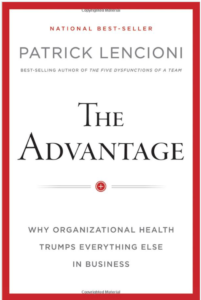Table of Contents
Organizational effectiveness is on the mind of every business leader. More so in times of change and chaos.
What determines organizational effectiveness is the balance of organizational health & organizational smarts.
The following article will provide a keyhole view into these two critical parameters which must be in sync to provide for continued organizational success and the ability to compete in a cut-throat business world.
Smart Vs. Healthy – The Two Strategic Planning Requirements for Organizational Effectiveness

The notion of what is a success in the organizational context is not as simple as it seems.
This is because success is multi-faceted, with many different and various parameters, with short and long-term considerations and effects, all of which are an integral part of the organizational effectiveness and success.
Having written that I would immediately add that the perception of success is extremely limited which limits what organizations do to bring success.
It’s all about perception and here, in this article, I will provide a perception that is fact-based and not a fake perception that is based on idealism which is stress producing throughout the corporate world.
The fact that success is so limited in its scope causes unnecessary stress and limits productivity and the range of success.
What Is The Meaning Of Smart & Healthy

There are two main considerations that are termed here SMART and HEALTHY, which are the main parameters of organizational effectiveness. Understanding what they are and how they influence corporate success is critical.
Right from the start, it should be pointed out that Smart and Healthy are complementing business disciplines and not antagonistic to each other when in balance.
Briefly;
“Smart” refers to parameters such as strategy, marketing, finance, technology, which are the “bread and butter” of the day-to-day operations of companies and organizations everywhere.
It is what professionals do on a daily basis, so it’s very important.
“Healthy” here, refers to how an organization proceeds with its workforce, its leadership and the human or soft skills they possess
The symptoms of a Healthy organization are cohesive teamwork, minimal politics, minimal confusion, high morale, high productivity & low employee turnover (and who wouldn’t want to be part of that?).
The Meaning Of Organizational Effectiveness

A Healthy organization is first and foremost cohesive and unified, where all parts pull in the same direction, absent of divisiveness and personal politics and backstabbing.
Meaning, that it operates as a whole, in a cohesive manner where its management, workforce, day-to-day operations, strategy, leadership, and culture are all in sync.
Again, it is not divided, not political, departments do not undermine each other, no ego considerations, no boring meetings, no favoritism, no backbiting, and a few other “nos”.
This is the true meaning of integrity. (The words integral, integrity and integrate provide a great clue to what true teamwork is about)
“Smart” In The Context Of Organizational Effectiveness

Smart organizations excel in all the classic business fundamentals: strategy, technology, marketing, finance, data analysis, and others, which are all very important as they focus on making the right business decisions.
“Organizational Smarts” is the ability to navigate through rough waters by doing all the hard-nose things that organizations must do to be competitive and profitable.
However, this is only 50% of what organizational effectiveness is about for long term success.
For a company to be optimally smart, it has to be healthy, and this is where most organizations fail miserably.
These two parameters must integrate and be in sync if there is to be a high level of organizational effectiveness. “Smart” without Organizational Health is “gradually diminishing smart”.
How can you have a smart organization if it has unhealthy practices?
You can’t.
In an unhealthy organization, people will only ever produce perfunctorily and never give their best. (…as I am sure you well know), while today, nothing short than an “inspired best” will do.
Ok, So What’s The Problem?
The problem is that although this may be understood by leaders everywhere, who find that their “smart” agenda is negatively compromised by an unhealthy work environment in their organization, they, strangely, continue to couple with Smart only.
They seem to solely (almost), invest their resources in getting smarter in the hope that it will solve their problems, which stem from being unhealthy…if that makes sense! 
Very simply put, the problem is that the need to attend to the Healthy part is largely overlooked and ignored by most executives who seem to think that getting smarter is the solution to all problems.
The problem is that smart is based on healthy and if you don’t strengthen the healthy part your organizational effectiveness will begin to diminish.
It isn’t possible to maximize organizational effectiveness without organizational health!
Why Is The Main Parameter Of Organizational Effectiveness Ignored?

Executives feel secure about studying spreadsheets, excel in data-driven analysis, and other familiar disciplines that they were trained at.
They are familiar & comfortable with such predictable practices, while “all this Healthy Business” is uncomfortable and represents an unknown territory, which is somewhat threatening and difficult to measure in spreadsheets.
It is a strange thing because everyone knows that the next creative success, almost always, comes from outside our comfort zone. What we haven’t experienced yet, what we feel awkward with, what we are not sure about, and unconfident about and more.
Yet, we religiously stick to what we know despite knowing that, doing the same things and expecting different results all along.
Einstein called it insanity and I have witnessed this insanity first hand in my many international leadership training for over a quarter of a century, persisting without fail.
Furthermore, the adrenaline rush of every day “doing” agenda of writing endless emails, running from one meeting to another, and generally being on the “fast lane” of corporate life, is all too stimulating and gives the illusion that we are doing a lot.
With an adrenalin rush who wants to slow down and invest in soft skills training like strategic thinking or strategic planning or emotional intelligence or many others?
After all, this kind of training requires a very different perception from the leadership about what constitutes a long term organizational effectiveness.
Getting healthy starts by changing pace, changing perception and mentality, and getting a new perspective on EQ as the main driver of organizational effectiveness.
This has to be on a different plane of leadership intelligence that is not “Me, Me, Me” based in its core orientation but rather a true service-oriented leadership that sees its function as an honor and not self-serving.
Furthermore, you cannot evaluate or quantify organizational health as you measure marketing.
“Health” parameters impact many different aspects of the company, some short-term but most are long-term and you need to look at it in different, unconventional ways.
The human DNA is not conventional!
How can you measure, for example, the connection between a happy workforce to minimizing errors in decision making? (which would translate to greater financial profits…)
Another small factor, but nevertheless important, is the fact that there is no sophistication and no prestige about making the organization healthy.
It’s not “sexy”, it’s not complicated and it’s not exciting.
Organizational health is simple, without complicated schemes. It is strategic thinking and strategic planning manifesting change in practical and effective ways.
The EQ Impact On Organizational Effectiveness

However, this is not about the logical reasons that prevent organizations from getting healthy.
It is about the emotions at play and the different fears, known or unknown, that prevent organizations from courageously launching into what is needed to bring about organizational health.
Here is the real point: The opportunities and business advantages that smart disciplines offer are limited in scope and potential because everyone knows the same “smart” parameters and all organizations, eventually, become “averagely” smart.
However, where it really counts, in truly investing in the soft skills of the workforce, only a few and far between companies have taken that strategy on board and stuck to it.
Organizational effectiveness is impossible to achieve without Emotional Health.
It shows up in so many different ways, like Empathy, workforce inter support, trust, workforce confidence to be creative without the gripping fear of making mistakes, doing extra and so much more.
Lack of organizational health indicates that there is a very limited understanding of what human soft skills wealth is all about.
It indicates a lack of value of the workforce by the leadership and generally limited perceptions about the real meaning of success, almost to the point of treating humans as robots.
Where organizational health exists E-motions can be a source of great motivation and inspiration, which, always, always, translated to organizational effectiveness and maximized profitability.
Yes, correct Emotional intelligence is one of the best financial strategy bar none.
So What’s The Big Deal?

Well, what makes this a “big deal” is that most executives acknowledge this critical deficit in their organization, see that it’s the missing link to greatness, and yet…hunker down and try to get… smarter!
It’s a big deal because they miss out on truly becoming a great organization and maximizing organizational effectiveness by focusing on organizational health.
Tapping into the wealth of talent that their workforce possesses & uncovering the great potential in people is what they miss. That’s what health practices of an organization can reveal.
As the old adage goes, “You never know what you miss.” I would add to that “and you, therefore, leave a lot of money on the table”!
The First And Most Important Symptom Of An Unhealthy Organization

The first symptom of a lack of health in an organization and the most counterproductive to organizational effectiveness is a Dysfunctional Executive Team and consequently dysfunctional teamwork throughout the company!
I am sure you know that, but I think it is important to reaffirm the fact and make it abundantly clear. That’s the critical thinking I focus on every time when I help organizations become healthier.
There are so many resources that go to waste when teams are dysfunctional (starting with the executive team) that it’s hard to believe!
Organizational effectiveness takes a beating when valuable energy is diverted to deal with internal politics, with a lack of trust, with the fear-based environment and the bureaucracy it results in.
It takes away from productivity, from morale, from an effective decision-making level, and from so much more.
Think about all the energy that companies waste because of an unhealthy environment, which, curiously enough, they’ll almost always attribute to lack of smarts.
It never ends well and always takes away from the bottom line of organizational effectiveness, and ultimately, from profits
(If you study the analysis of companies that fail you’ll see that their failure is attributed to lack of smarts when the deeper fact points clearly to the absence of organizational health)
Fact: An overwhelming amount of studies indicate that companies are at a 20% level of organizational effectiveness
How Healthy And Smart Fare When Weighed?
Simple answer, healthy organizations will become smart very quickly because they tap into their human wealth, while smart organizations will max-out quickly and will start to decline soon thereafter.
What Can Be Done?

The first step in healing an organization (for lack of a better word) is to seriously address the aspect of dysfunctional teamwork.
By adopting a strategic team building plan and mending the “human divide”, that exists in so many organizations, the “health meter” begins to rise.
The difference between “cohesive teams” and “working groups that are working together” without team strategy, is huge, where organizational effectiveness is concerned!
Anyone who ever worked in a divisive environment knows the terrible feeling of politics, ambiguities, lack of unity, backbiting, and bureaucracy that seems to halt any possible advancement and makes people feel miserable about their workplace.
What would you prefer; a cohesive team environment where people are truly together and tap into the power of positive thinking? Or one that is characterized by dysfunctional teamwork and negativity where people attack and suspect each other?
Which of those will be smarter, more profitable, more competitive, with better morale and reduced turnover of employees?
The answer is pretty obvious, isn’t it?
Finally
As you can see, Organizational effectiveness and how it connects to organizational health is a huge subject that needs much more than an article.
Hopefully, you as the reader can see the significance of the soft skills training in your organization and begin to see the hypocrisy of demanding people to do their best without giving them the training resources to be at their best.
What they need is to come to work and feel happy about it, trust their leadership, support their counterparts, and contribute to the success and to the organizational effectiveness like “there is no tomorrow”.
That’s the spirit that belongs to organizational health.
It is simple. It is straight forward. It’s doable. It’s sorely missing. It requires ongoing soft skills training.
Call on me I am here for you
Eli Harari
The Life Coach for Professionals™


Pingback: How Thinking Strategically Can Save You From Future Downturns
Pingback: Win The Competition With A Winning Strategic Planning Process
Pingback: Why Perception Trumps The Truth Every Time
Pingback: 4 Ways to Achieve Organizational Performance & Effectiveness - The Thinking Coach
Pingback: Redefining WhInvesting In Team Building Training Is The Best ROI With Millennials & Z'sat Is Team Building In The 21st Century